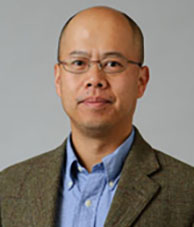
报告题目:Helical Cooperativity and Helical Chain Growth Mechanisms in Polypeptide-containing Complex Macromolecules
报告人:Prof. Yao Lin (Department of Chemistry and Institute of Materials Science, University of Connecticut)
报告时间:2019年10月11日10:30
报告地点:蒙民伟楼201报告厅
报告人简介:
Yao Lin is a full Professor of Chemistry Department and Polymer Program at the Institute of Materials Science at University of Connecticut. He received his Ph.D. in Polymer Science and Engineering from University of Massachusetts, Amherst in 2005. After completing his George W. Beadle postdoctoral fellowship at the Argonne National Laboratory and the University of Chicago in the field of biosciences and chemistry, he joined the UConn faculty in late 2008。 His current research interests primarily focus on bio-inspired macromolecules and materials
报告摘要
Through evolution, many biological systems now possess great complexity with dynamic and synergistic actions (a class of molecular cooperativity). Probably the best way to quantitatively understand how a complex molecular system works is to create a simplified model system from scratch, using different subunits but based on the same physical principles. For this reason, my research focuses on bioinspired molecular engineering of complex system using synthetic and hybrid macromolecules. In the last several years, we have made progress towards our goals in mimicking: (1) the polymerization motors of actin filaments and microtubules, and (2) the auto-catalytic polymerization facilitated by macromolecular architectures. To handle the high complexity of the chemical systems, we have revised and developed several thermodynamic, kinetic and statistical mechanical models to guide our molecular designs and to obtain in-depth understanding of the mechanisms. These models share common features with the classic cooperativity theories proposed by Fumio Oosawa, Bruno Zimm and Terrell Hill. In this talk, I will give a couple of examples on how to integrate theoretical and experimental approaches to facilitate model-driven engineering of complex, polypeptide-based systems with strong cooperative behaviors.
References:
1. J. Wang, H. Lu, R. Kamat, S. V. Pingali, V. S. Urban, J. Cheng* & Y. Lin*, “Supramolecular polymerization from polypeptide-grafted comb polymers,” Journal of the American Chemical Society, 133, 12906-12909 (2011).
2. H. Xia, H. Fu, Y. Zhang, K. Shih, Y. Ren, M. Anuganti, M. Nieh, J. Cheng*, and Y. Lin*, “Supramolecular Assembly of Comb-like Macromolecules Induced by Chemical Reactions that Modulate the Macromolecular Interactions in-situ,” Journal of the American Chemical Society, 139, 11106–11116 (2017).
3. Y. Ren, R. Baumgartner, H. Fu, P. Schoot, J. Cheng*, and Y. Lin*, “Revisiting the Folding Cooperativity of Synthetic Polypeptides in Solution,” Biomacromolecules, 18, 2324-2332 (2017).
4. Y. Ren, H. Fu, R. Baumgartner, Y. Zhang, J. Cheng*, and Y. Lin*, “Folding Cooperativity of Synthetic Polypeptides with or without “Tertiary” Interactions,” ACS Macro Letters, 6, 733–737 (2017).
5. R. Baumgartner, H. Fu, Z. Song, Y. Lin* and J. Cheng*, “Cooperative Polymerization of α-Helices Induced by Macromolecular Architecture,” Nature Chemistry, 9, 614-622 (2017).
6. Z. Song, H. Fu, J. Wang, J. Hui, T. Xue, L. A. Pacheco, H. Yane, R. Baumgartner, Z. Wang, Y. Xia, X. Wang, L. Yin, C. Chen, J. Rodríguez-López, A. L. Ferguson, Y. Lin*, and J. Cheng*, “Synthesis of polypeptides via bioinspired polymerization of in situ purified N-carboxyanhydrides,” Proceedings of the National Academy of Sciences of the United States of America, 116, 10658-10663 (2019).